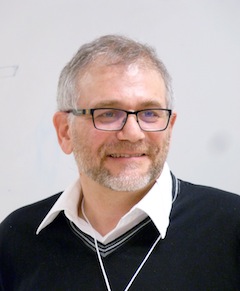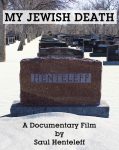If you have ever wondered what will happen after your death – when your soul leaves your body but you have not yet been buried – a new film by Saul Henteleff walks you through precisely that experience.
The 30-minute documentary My Jewish Death was screened at Winnipeg’s Limmud festival on March 13. In the film, Henteleff plays a recently deceased person who is taken through the steps of a mock tahara, the Jewish ritual wherein the chevra kadisha (burial society) prepares the body for its final rest. Tahara is done by volunteers and is the main focus of the movie.
The film, which took 10 years to make, includes interviews with several local rabbis, as well as the executive director of Winnipeg’s Chesed Shel Emes, Rena Boroditsky, who was present at the Limmud event, along with Henteleff, to answer questions.

When asked how it felt to play the role of someone who has died, Henteleff said, “I felt very well taken care of. I also think about the filmmaking … everything is broken down into steps. It’s, thankfully, pretty continuous from beginning to end, but we’d start and stop and reshoot. I tried to hold my breath. There are a few things going on there. More so, I had a chance to reflect on it as the edit was coming together.”
When asked if the film changed him, Henteleff replied that he was very skeptical about the whole concept before he started. “When I heard Rabbi [Neal] Rose talking about the afterlife, there were things about it that I just found to be ridiculous. As I was going through the process and the power of these things, that’s when my mind changed and my feeling about the whole thing shifted.
“These are things we hold as a community – I’m Jewish – that we identify with. I saw the value or importance and the respect that it carries: sand on the eyes, the pieces of clay sprinkled on the eyes and groin. These things have been going on for centuries … if we take it seriously, it’s very important.”
Many attendees expressed their gratitude for the film having been made and described it as a “must-see film for Jews.”
In the documentary, it is explained that men are buried with a tallit (prayer shawl) supplied by the deceased’s family, while women are generally not.
While Boroditsky assists in the tahara in the film, in reality, only men perform this ritual for men. “There was some artistic licence taken for the film,” she said. “Normally, we have women who look after women and men who look after men.”
At the screening, Henteleff shared that he was trained before the making of the film and has been volunteering with the chevra kadisha for three or four years now. He also said there were a number of people who were not comfortable with him undergoing the ritual.
“It’s pretty controversial, even when we have a conference and we do a demonstration,” said Boroditsky. “Should we do a demonstration on a live person even though we don’t wash her? Should we cover her face? To do tahara on a live person, not everyone felt comfortable with that. This film is one of a kind.
“The basics of tahara are the same. Around the world, it’s trans-denominational – Reform, Reconstructionist, Orthodox – the basics of tahara are the same…. Some of the prayers may be different, depending on who is doing it and the outfit might be different; one more piece, one less. This is one of the things in Judaism that is universal and very similar all around the world.”
Any Jewish person being buried in one of the four main Jewish cemeteries in Winnipeg must have the ritual performed. People who are buried at the Temple Shalom cemetery at Chapel Lawn have the option of having tahara done at the Chapel Lawn funeral home by trained members of Temple Shalom.
As for the casket, Boroditsky said, “A kosher casket is made from wood with no metal pieces, and usually has rope handles. It’s held together with dowels and glue, no nails. So, that can be what they would call a plain pine box.
“In Toronto and Montreal, where it is more of a commercial funeral home, they offer … a full range of caskets. In every other community outside of Toronto and Montreal – Calgary, Edmonton, Winnipeg and Vancouver – we have a choice of one casket. Our caskets are $550, to keep things as low cost as possible.”
In the case of infants less than 30 days old who have passed away, there is no tahara required. Boroditsky speculated the reason for this as having to do with the fact that, back when the rules were made, infant mortality was very high.
“If you mourned a year for every child, people wouldn’t have been able to live,” said Boroditsky. “Certainly now, the Conservative movement and Reform movement have developed rituals for services for infants, for stillborns and for babies. There has been some movement in that.”
My Jewish Death will be distributed widely in coming months. The trailer is available on YouTube.
Rebeca Kuropatwa is a Winnipeg freelance writer.

